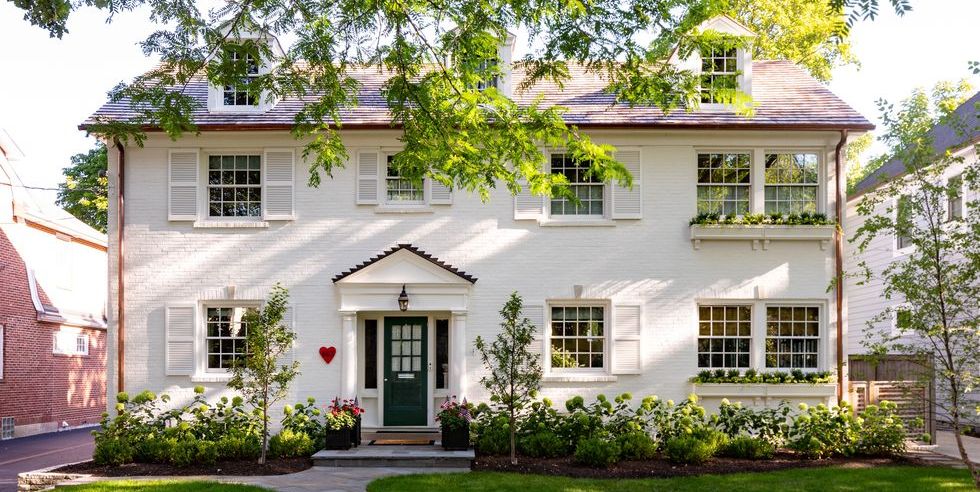
HERE'S WHY PAINTING BRICK IS OUR FAVORITE DIY
Painting brick can be an easy way to update the look of any exterior or interior space. While raw red brick is beautiful in many contexts, there are other instances where painting the brick is a good idea, whether as a means of brightening a room or boosting the curb appeal of your home. You've probably seen how a crisp white painted fireplace can transform a living room. However, painting brick isn't as straightforward as rolling a new color onto the wall. If you don't choose the best paint or primer or prep the surface well, you could end up with a flaky finish, an uneven look, or even an alkali-burned topcoat.
To help ensure you nail this project during your next DIY weekend, we tapped Octave Villar, applications and lab manager at Kilz Primers & Paints, to find out what you should know before picking up a brush. Read his advice on how to paint brick below, along with step-by-step instructions for your own project.
What to Consider When Painting Brick
Before you decide to paint the brick on the interior or exterior of your home, there are a few important factors to consider. First and foremost, you need to know how recently that brick was installed. The reason? New brick often isn't a good candidate for painting. "Brand-new brick and mortar can exude a powdery substance, so you want to give it at least a month to cure before painting it," says Villar. "Otherwise, it's going to be super chalky and not hold on to the paint as well."
Beyond that, know that painting your brick is a (relatively) permanent decision. Getting paint off once it's properly applied is no small feat, so you want to feel confident about your decision to coat your bricks. Whatever area you're painting should be free of water damage, and any fixes (including new mortar, hairline cracks, and loose bricks) should be addressed properly before proceeding to paint.
How to Paint Brick
Though every job is different, there are some standard steps to follow when painting a brick interior or exterior. Below, we'll walk you through the how-to and outline what you need to pick up from the hardware store ahead of time.
You'll need:
- Dish soap
- Water
- Wire scrub brush
- Power washer (as needed for exterior jobs)
- Painter's tape
- Multipurpose primer
- Latex paint
- Paint brush
- Paint roller
- Drop cloths (as needed)
- Painter's tape (as needed)
Step 1: Prep the Brick Surface
You'll need to make sure sure the brick surface is totally clean of loose debris or greasy stains before you start priming. "If you don't wash the brick first, you're basically just painting over sand and dust, and it won't bind," says Villar. A light power wash will usually suffice for exterior brick; for interiors, a thorough cleaning with dish soap and water should do the trick. You can also use a wire scrub brush as needed to smooth any overly rough surfaces or dislodge stray chunks of mortar. Give the brick ample time to dry—at least one to two full days—then tape off any areas you don't want to paint.
Step 2: Paint on Primer
No matter whether the brick you're painting is old or new, interior or exterior, you absolutely must use a primer. "You want a primer that will 'bite' into the brick; the better it can wrap around those pores and get into all the nooks and crannies, the better the paint will adhere," says Villar. Primers made for brick and masonry are your best bet, like Kilz 2 All-Purpose Interior and Exterior Primer. "They're usually a little thinner, which helps the primer penetrate into brick's porous surface and bind any chalky or loose materials, and they have more alkaline resistance, which keeps the top coat of paint from getting alkali burn," he explains.
Since you're dealing with a material that's far more rough and porous than typical drywall, you're going to need an applicator that can stand up to wear and tear. "Use a synthetic bristle brush, and don't go cheap," warns Villar. His pick: a Chinex brush, "which is designed to take a beating without becoming bent and misshapen," he says. If you're painting larger areas and want to use a roller, choose one with a high nap—at least half an inch, says Villar—which will ensure that the primer gets into all the crevices. Let your primer dry completely between coats and before topping with paint.
Step 3: Paint Your Brick
Once the all-important prep work is complete, you can go ahead and apply the paint color of your choice. Any sheen or formula will work just fine as long as you've primed. "Generally people like to use a higher-sheen formula on brick because it's more resistant to marring and staining, but you can also use an eggshell or flat finish if that's the look you want," says Villar. Latex paint will be more quick-drying and easier to clean up, whereas oil-based paint will dry to a harder finish. Painted brick shouldn't require a sealer—just make sure to choose a wear-resistant exterior paint if the brick will be exposed to the elements.
Follow House Beautiful on Instagram.
2023-05-25T20:31:26Z dg43tfdfdgfd